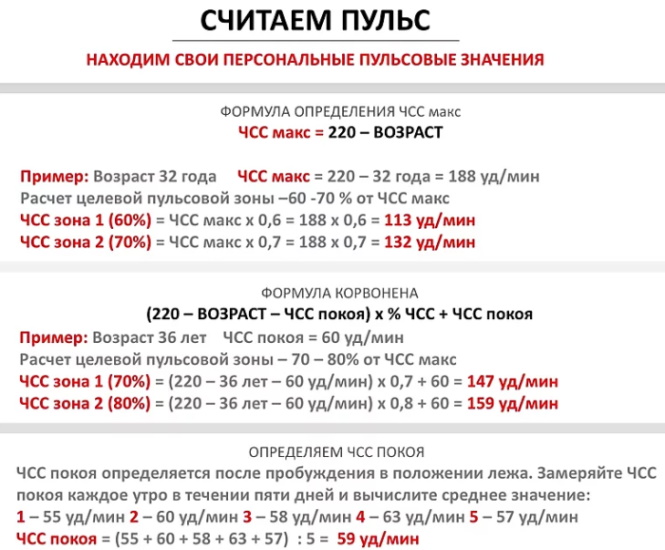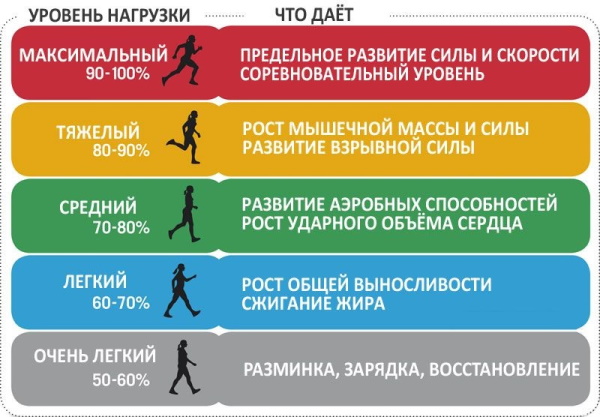During rest and when physical activity heart rate is different. Much depends on whether a person is involved in professional sports.
Typically, at rest, the pulse is 60-90 beats / min. However, for an athlete who has been doing strength exercises for a long time, this figure can be 2 times lower. For professionals, the pulse rises only during active activities or in case of severe stress.
Heart rate zone
Pulse is the heart rate (HR) over a minute. There is also the concept of the pulse zone, which defines the range from resting heart rate to maximum load on the body.
In everyday life, it is not at all necessary for a person to monitor the heart rate zone. However, this parameter is very important for athletes. The fact is that when the heart rate is in one zone, it contributes to weight loss, and at the maximum value, the body's endurance increases.
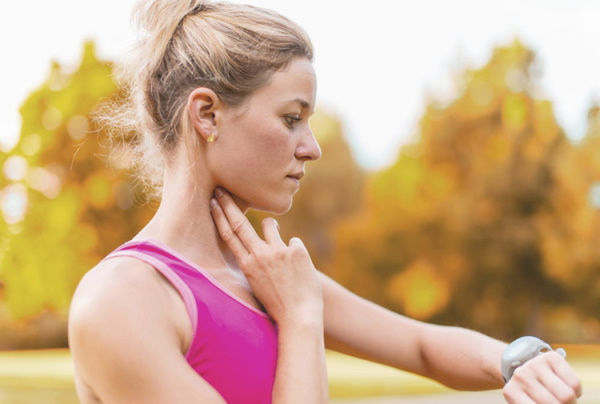
Heart rate, permissible maximum heart rate
In a healthy middle-aged person, the resting heart rate is about 65-75 beats / min. If we are talking about an indicator above 90 beats / min, then such a condition is usually called tachycardia (the heart beats faster). If the average heart rate falls below 60 beats / min, then this is a sign of bradycardia (heart rate slows down).
However, if we are talking about athletes, then for them at rest, a pulse of about 40 beats / min is normal. Also, heart rate decreases during sleep, which is also considered normal.
However, if you wish, you can independently calculate the average maximum value of the heart rate zone.... To do this, subtract your age from the number 220. For example, if a person is 35 years old, then it turns out 220 - 35 = 185.
That is, at this age, the pulse should not exceed 185 beats / min, if a person is involved in sports. However, you need to understand that this is an average value that differs depending on numerous parameters.
It should be borne in mind that these calculations are suitable only for those who have been involved in sports for a long time. In addition, this is not the only method for determining the maximum allowable heart rate.
There is one more calculation scheme:
- For men... To get data on the maximum allowable heart rate, you need to subtract the age of the man from 214, and then multiply the resulting figure by 0.8. For example, 214 - 35 = 179, then 179 * 0.8 = 143 bpm. That is, according to this scheme, at the age of 35, a man should not have a pulse higher than 143 beats / min.
- For women... Subtract age from 209 and multiply the resulting number by 0.7. For example, 209 - 35 = 174. Then you need to multiply 174 by 0.7, you get 121.8 bpm. This is the maximum limit that is recommended for women aged 35 years.
You can also calculate the maximum allowable value even more accurately if you take into account not only the age, but also the weight of the person:
- For men... Subtract from 210 ½ age. For example, 210 - 17.5 = 192.5.Next, you need to subtract 5% of the man's body weight from the resulting number. That is, if he is 35 years old, and he weighs 100 kg, then it turns out 192.5 - 5 = 187.5. It remains to add 4, that is, 191.5 beats / min.
- For women... The calculation is the same, only you do not need to add 4. That is, if a woman is 35 years old and her weight is 60 kg, then it turns out 210 - 17.5 = 192.5. Then 192.5 - 3 = 189.5 beats / min.
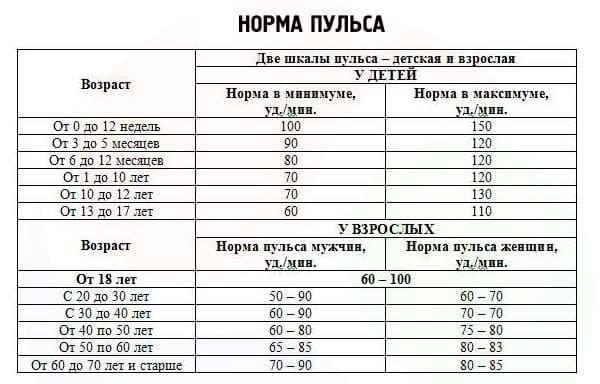
The pulse during physical exertion (the rate is calculated individually) and under other conditions may increase against the background of the following reasons:
- With sports training that is aimed at cardio loads.
- Out of fear, or, conversely, strong joy. Also, the pulse rises in a stressful situation if a person is very worried.
- If the body temperature rises to 37 ° C or higher, or if the environment is very hot.
- Due to hormonal changes in the body.
It is noteworthy that in the morning the heart rate is calmer, and in the evening it becomes more frequent.
It is also worth noting the so-called zones of severity of classes:
| The zone of severity of classes (how many beats / min) | Name | Under what conditions is it considered the norm |
| 50-60% (95-115) | Initial (warm-up zone) | During a light run. The workout is aimed at strengthening the cardiovascular system. Breathing should be calm, the person can speak. This type of load is suitable for a beginner. |
| 60-70% (115-135) | Initial (activity zone) | More intense light running, during which fat is actively burned. This type of workout is also suitable for beginners and those looking to lose weight. |
| 70-80% (135-150) | Fitness (aerobic zone) | Exercises aimed at developing endurance. Breathing becomes more rapid, it is difficult to talk. |
| 80-90% (150-170) | Anaerobic (endurance zone) | Power training. This heart rate level is allowed only for a prepared organism. Otherwise, the condition is considered dangerous. Redness of the face is observed. It's almost impossible to talk. |
| 90-100% (170-180) | Red line (danger zone) | Endurance and speed training. Only suitable for experienced professionals. This type of workout can only be done after a fairly long period of time. |
Pulse dependence on age
Pulse during physical activity (the rate depends on age, weight, health status and much more) can change throughout life... Heart rate is the main indicator of a person's health status. That is why the doctor begins to assess the heartbeat even in a child who is in the womb of a woman.
Thus, from the first days of fetal life, possible pathological abnormalities can be diagnosed. Heart rate indicators can be in the range from 75 to 150 beats / min. If the pulse is weak, then this indicates a possible oxygen deficiency in the growing body.
The highest pulse rate in newborns. Over the years, it begins to decline. However, a child's pulse is always faster than that of an adult, since children are constantly in motion, thereby stimulating the contractions of the heart muscle. In addition, the child's body grows, and the heart becomes smaller in relation to it.
Therefore, in a calm state, a child may have a heart rate of 110-170 beats / min and this is considered the norm. By the age of 15, this figure drops to 60-80 beats / min. Separate normal heart rate range for athletes. However, as mentioned earlier, they should not bring the work of the heart to 100 percent.
The heart rate during physical exertion is as follows, if we generally assess different age categories:
- At 20 years old, the pulse is considered to be in the range of 100-170 beats / min.
- In 30 years, even with intensive training, the heart rate should not go beyond 95-160 beats / min.
- At 40 years old, 90-150 bpm is considered the norm.
- At 50, you should not overload the body too much. The pulse should be in the range of 85-140 beats / min.
- By the age of 60, this indicator decreases to 80-135 beats / min.
- At 70 and more years, the heart rate cannot be allowed to go beyond 60-120 beats / min.
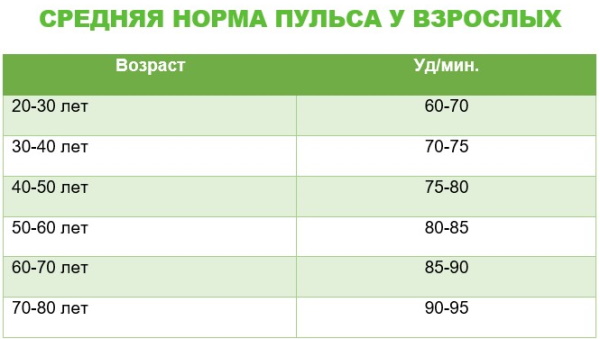
What pulse should be during physical activity
In many ways, the heart rate depends on the specific load. When walking and exercising, heart rate indicators are different and have their own characteristics.
When walking
During normal walking, the norm is from 100 to 150 bpm. If these indicators increase, then the person develops shortness of breath, dizziness, tingling in the side and heart area. If this happens, then this suggests that the person needs better physical fitness.
Walking belongs to the category of loads, which is estimated at 35% of the load. That is, this is an acceptable rate of severity for a person who does not play sports. That is why walking is most often recommended for the elderly.
With cardio training
Fitness workouts fall into this category. That is, the pulse should be in the range of 135-150 beats / min.... However, you must first undergo a specialized computer examination, which will help determine the lower and upper heart rate thresholds.
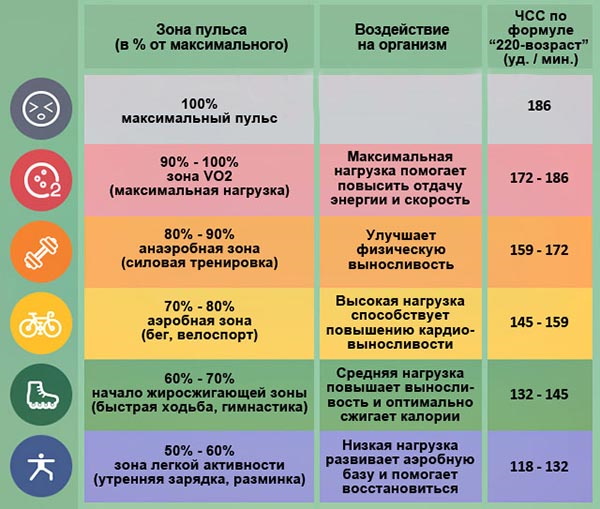
If we talk about cardio training, then the recommended duration of such exercises is 40-50 minutes.
Male indicators
The pulse during physical exertion (the norm for a strong half of humanity differs from the standard indicators of women) changes during the day. The values are influenced by the degree of fitness of men. For example, an athlete's heart rate is about 20-30% lower than that of those who do not train.
If we talk about men, then their pulse can change depending on conditions. For instance:
- With active walking, the heart rate is about 90-100 beats / min. If, when walking, the pulse rises to 120 beats / min, then this is not considered critical in the event that a man does not have shortness of breath or dizziness.
- In a calm state, the heart rate indicators are in the range of 60-80 beats / min.
- If a man is overweight and leads a sedentary lifestyle, then the heart rate can be up to 120 beats / min.
After training, the man's pulse recovers in about 30 minutes.
For girls
In the fairer sex, the pulse may change depending on more factors. For example, heart rate changes during the menstrual cycle, pregnancy, weight gain, overeating.
During physical exertion, the pulse intensity in a woman aged 20 years should be 110-150 beats / min. At the age of 30-40, this indicator decreases to 105-140 beats / min. After training, the heart rate should recover in about 20 minutes. If training is aimed at endurance, then full recovery occurs in 40 minutes.
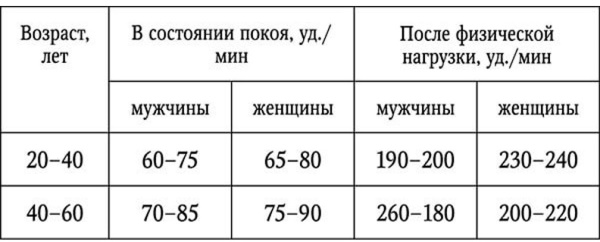
Also, the pulse of men and women is greatly influenced by lifestyle. If a person very often drinks coffee, drinks alcohol and smokes, then the heart rate will not be stable and can increase without physical exertion.
In childhood
In this case, normal heart rate indicators can be divided into several periods:
- In a newborn... During this period, the child's pulse is 120-140 beats / min.However, it also takes into account how long the child was in the womb. Premature babies have a faster heart rate.
- In a baby... By the first month of life, the baby's pulse begins to gradually decrease. By the age of 1 year, as a rule, it is about 132 bpm.
- In young years... The average heart rate at 2 years is 124 beats / min. However, at this age the child is very active, he is constantly in motion, the emotional state can often change. Therefore, the norm is considered to be a heart rate in the range of 94-154 beats / min. With such parameters, there is no reason to assume the presence of pathology.
- At the preschooler... At the age of 5-6 years, the pulse is considered normal with an indicator of about 106 beats / min. Gradually, the heart rate stabilizes, as does the child's morale.
- At a schoolboy. At 10 years old, the heart rate is 68-108 beats / min. However, at 7 years old, the heart rate will be higher despite the fact that this is the same age category. It is recommended to consult a doctor more precisely at this age.
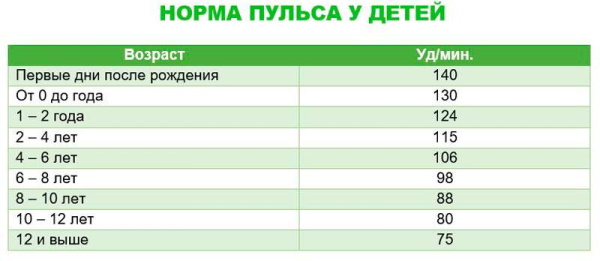
For active people
The most stable heart rate indicators are observed in people aged 15 to 50 years. If we talk about the heart rate of athletes, then there is no unambiguous optimal value, since everything depends on the specific load.
When doing aerobics, the heart rate is usually slower, and when running, it can reach its maximum value. Heart rate also differs when swimming, cycling. To calculate the approximate parameter of an athlete's maximum heart rate while running, multiply the person's age by 1.03 and subtract the resulting number from 220.
For example, if an athlete is 30 years old, then 1.03 * 30 = 30.9. After that, you need to subtract this number from 220, you get 189.1 bpm. However, during a regular workout that does not involve running, the maximum value is usually considered to be 180 bpm.
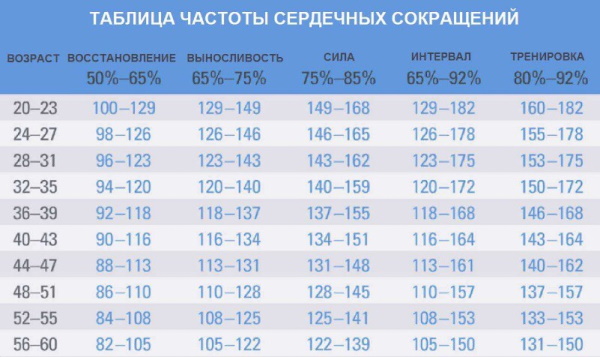
Instructions
The pulse during physical exertion (the norm for each person may be different) is recommended to be measured by a doctor or using specialized equipment. As a rule, a tonometer is used for this (a device that allows you to obtain data on pressure and heart rate). However, you can measure your heart rate without additional equipment.
For example, in a newborn baby, the pulse is most clearly felt on the neck in the area where the carotid artery is located. To determine the pulse in older children, adolescents and adults, measurements are usually taken from the radial artery. It is located on the inside of your wrist.
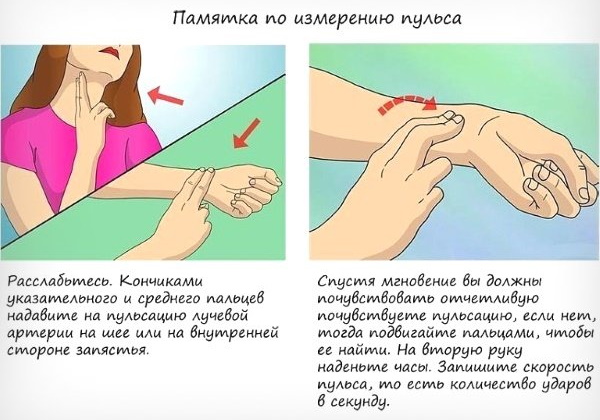
- First of all, you need to press a little with your index and middle fingers on an area that is 2 cm higher than the first crease on the wrist.
- Next, you need to count the pulsations for 15 or 30 seconds. It is best to use a stopwatch for this.
- After that, the resulting number must be multiplied by 4 (if the measurement lasts 15 seconds) or by 2 (if changed over 30 seconds).
It is recommended to take such measurements in the morning. It is also important to ensure that the room where the procedure is performed is quite warm. If a person is cold, then the heart rate automatically rises. It is also not recommended to measure the pulse immediately after eating.
Also today on sale there are various bracelets that allow you to accurately determine the readings of the heartbeat. These devices are especially popular among professional athletes.
A device of this type takes heart rate measurements at a specified time interval. The bracelet then vibrates or beeps. It remains only to evaluate the readings. However, experts question the accuracy of such gadgets.
Possible violations
If the pulse is too fast or, conversely, slower than it should be according to the standards, then perhaps we are talking about a deviation.
If, after all the calculations, the pulse is outside the permissible norm, then you need to find a way to normalize the indicators. First of all, you need to re-measure about half an hour after the first. During this time, it is worth having a good rest and avoiding physical exertion. Breathing exercises help some cope with the problem.
If, after repeated measurement, the pulse is again very different from the norm, then you need to understand why this happens.
Low rates
This condition is called bradycardia, that is, the heart rate is below normal. If at the same time a person does not feel weak and continues his usual sports training, without noticing any deviations for the worse, then this condition does not apply to disorders or malfunctions in the body.
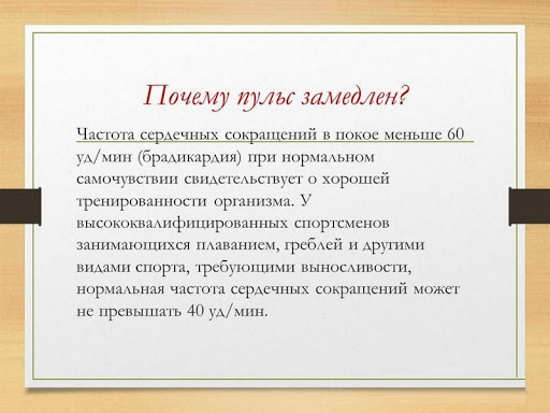
- weakness;
- dizziness;
- nausea;
- lack of appetite;
- rapid fatigue.
If at least one of these symptoms appears, it is recommended to consult a doctor in order to understand the cause of a decrease in pulse rate and malaise.
High performance
With an increase in heart rate, you need to make sure that the change in heart rate is not associated with:
- overwork after intense physical exertion;
- severe emotional stress;
- anemia, which is characterized by low hemoglobin levels;
- an increase in body temperature, as a consequence of the initial stage of a viral disease;
- disturbances in the work of the cardiovascular or respiratory system.
An increase in heart rate is not considered normal if it exceeds the standard values by 20%.
With an increase in heart rate, you should immediately consult a doctor if, simultaneously with an increase in heart rate, confusion, dizziness, vomiting and nausea are observed. Also, with an increased heart rate, a person may have a light-headed state, sweating increases, and vision becomes worse.
Who is prohibited from training
If a person experiences severe discomfort after training, and the heart rate indicators are recovering for too long, then it is worth revising the exercise regimen and switching to a simpler level of physical activity.
Do not engage in sports activities in case of cardiovascular and oncological diseases, as well as in case of poisoning... Also, doctors prohibit training for those diagnosed with hormonal disorders and malfunctions of the central nervous system. If the pulse does not equalize within 40 minutes. after completing a workout, this is an excuse to visit a therapist and cardiologist.
For those involved in sports, the heart rate is an extremely important parameter.
Before starting training, with future physical exertion, it is imperative to determine the maximum and minimum permissible heart rate values and only after that start training.
Gradually, the body will strengthen and during training, the heart rate will be lower, close to those indicators that are normal for a person in a calm state.
Video on the topic: change in heart rate during physical activity
Change in heart rate during exercise:

